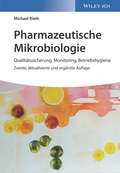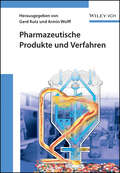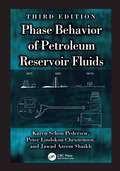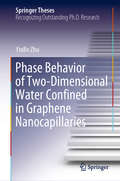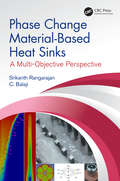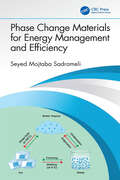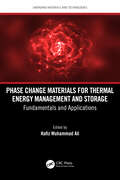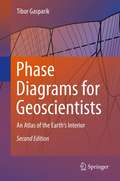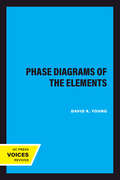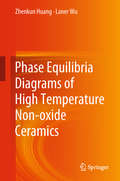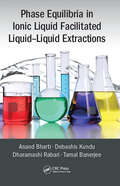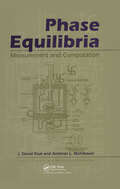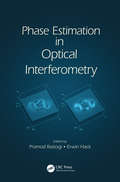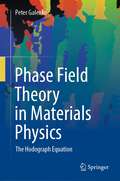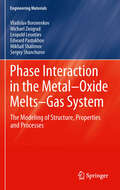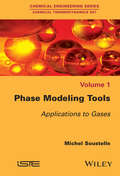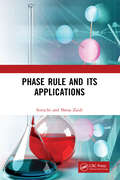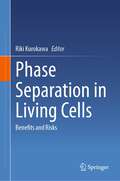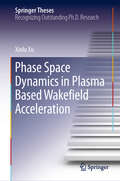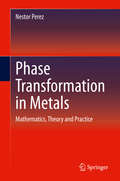- Table View
- List View
Pharmacy and Professionalization in the British Empire, 1780–1970 (Medicine and Biomedical Sciences in Modern History)
by Stuart AndersonOffering a valuable resource for medical and other historians, this book explores the processes by which pharmacy in Britain and its colonies separated from medicine and made the transition from trade to profession during the nineteenth and twentieth centuries. When the Pharmaceutical Society of Great Britain was founded in 1841, its founders considered pharmacy to be a branch of medicine. However, the 1852 Pharmacy Act made the exclusion of pharmacists from the medical profession inevitable, and in 1864 the General Medical Council decided that pharmacy legislation was best left to pharmacists themselves. Yet across the Empire, pharmacy struggled to establish itself as an autonomous profession, with doctors in many colonies reluctant to surrender control over pharmacy. In this book the author traces the professionalization of pharmacy by exploring issues including collective action by pharmacists, the role of the state, the passage of legislation, the extension of education, and its separation from medicine. The author considers the extent to which the British model of pharmacy shaped pharmacy in the Empire, exploring the situation in the Divisions of Empire where the 1914 British Pharmacopoeia applied: Canada, the West Indies, the Mediterranean colonies, the colonies in West and South Africa, India and the Eastern colonies, Australia, New Zealand, and the Western Pacific Islands. This insightful and wide-ranging book offers a unique history of British pharmaceutical policy and practice within the colonial world, and provides a firm foundation for further studies in this under-researched aspect of the history of medicine.
Pharmazeutische Mikrobiologie: Qualitätssicherung, Monitoring, Betriebshygiene
by Michael RiethIn seinem Buch zur pharmazeutischen Mikrobiologie geht Michael Rieth, promovierter Mikrobiologe mit langjähriger Erfahrung in mikrobiologischer Qualitätsprüfung in der pharmazeutischen Industrie, auf alle Aspekte dieses für die Pharmaproduktion unentbehrlichen Gebietes ein. Schwerpunkte sind Methoden der Qualitätskontrolle, das Umgebungsmonitoring in der Pharma- und Chemieproduktion sowie die Betriebshygiene. Der Fokus liegt auf bakteriologischen Verfahren einschließlich der mikrobiologischen Schnellmethoden; daneben werden aber auch Zellkulturmethoden und Tiermodelle behandelt. Für die zweite Auflage wurden unter anderem die Themen "Low Endotoxin Recovery" und Maskierung / Demaskierung von Endotoxinen neu aufgenommen. Wo immer möglich, werden die Bezüge zu den neuesten Ausgaben der europäischen und US-amerikanischen Arzneibücher hergestellt.
Pharmazeutische Produkte und Verfahren
by Herausgegeben von Gerd Kutz und Armin WolffA comprehensive overview of the demands on pharmaceutical products and manufacturing processes. It describes in detail the requirements for pharmaceutical production plants, production processes, equipment and machinery, as well as the accompanying qualification and validation measures. Suitable for both engineers in the pharmaceutical industry and in related sectors, as well as for researchers and students in chemical, pharmaceutical, biotechnological and technical courses.
Phase Analysis of Sound Fields: A System-Theoretical Approach
by Mikio TohyamaThis book deals with the phase properties in the context such as sound fields in rooms from a perspective of transfer functions for sound paths. Phase analysis, i.e., investigations of zeros of transfer functions, is a qualitative or system theoretic approach to sound fields rather than the wave-theoretic power spectral analysis. The examination of phase responses offers new insights into sound fields and yields results that the standard power spectral analysis cannot provide. This book presents experimental data and numerical examples based on the mathematical formulations. It shows the mathematical formulations of acoustics and communication systems for engineers and physicists to get familiar with the basics of science. Chapters 1–5 provide the theoretical basis on the system theoretic approach to sound fields where Chapters 1 and 2 are introductions to discrete acoustic systems, Chapters 3–5 summarize wave equations, geometrical and random theories of room acoustics, and Chapters 6–10 develop details of transfer functions in sound.
Phase Behavior of Petroleum Reservoir Fluids
by Karen Schou Pedersen Peter Lindskou Christensen Jawad Azeem ShaikhDeveloped in conjunction with several oil companies using experimental data for real reservoir fluids, Phase Behavior of Petroleum Reservoir Fluids introduces industry standard methods for modeling the phase behavior of petroleum reservoir fluids at different stages in the process. Keeping mathematics to a minimum, this book discusses sampling, characterization, compositional analyses, and equations of state used to simulate various pressure–volume–temperature (PVT) properties of reservoir fluids. The Third Edition has been updated throughout. Reflects advances in equation of state modeling for reservoir fluids and CO2-rich fluids Presents association models along with non-classical mixing rules for handling fluids with aqueous components Has an extended coverage of reservoir fluid communication, energy properties, and asphaltene precipitation Provides practical knowledge essential for achieving optimal design and cost-effective operations in a petroleum processing plant This book offers engineers working in the energy sector a solid understanding of the phase behavior of the various fluids present in a petroleum reservoir.
Phase Behavior of Two-Dimensional Water Confined in Graphene Nanocapillaries (Springer Theses)
by YinBo ZhuIn this book, the authors use molecular dynamics simulations to conduct a comprehensive study of the compression/superheating limit and phase transition of 2D (monolayer, bilayer, and trilayer) water/ice constrained in graphene nanocapillaries. When subjected to nanoscale confinement and under ultrahigh pressure, water and ice behave quite differently than their bulk counterparts, partly because the van der Waals pressure can spark a water-to-ice transformation, known as the metastability limit of two-dimensional (2D) liquids. From a mechanical standpoint, this liquid-to-solid transformation characterizes the compression limit (or metastability limit) of 2D water. The findings presented here could help us to better understand the phase behavior of 2D confined water/ice.
Phase Change Material-Based Heat Sinks: A Multi-Objective Perspective
by Srikanth Rangarajan C. BalajiPhase-change Material based heat sinks and associated optimization remains a topic of great interest, as evident from the increasing number of citations and new applications and miniaturization. Often the multi objective perspective of such heat sinks is ignored. This book introduces the readers to the PCM based heat sinks and Multi objective optimization. The authors have also included interesting in house experimental results on the "Rotating heat sinks" which is a first of a kind work. Useful to budding thermal researchers and practicing engineers in the field, this book is also a great start for students to understand the cooling applications in electronics and an asset to every library in a technical university. Since this book not only gives a critical review of the state of the art but also presents the authors' own results. The book will encourage, motivate and let the reader consider pursuing a research career in electronic cooling technologies.
Phase Change Materials for Energy Management and Efficiency
by Seyed Mojtaba SadrameliThis book explores the prospective applications of Phase Change Materials (PCMs) in energy storage systems, thermal system temperature control, peak shifting, and energy management. It starts with definitions and a brief history of energy storage systems, followed by an exploration of different types of PCMs, encapsulation techniques, heat transfer enhancement methods, and the applications and challenges of PCMs. The book provides a comprehensive overview of PCM applications in building envelopes, free cooling, electrical appliances, lithium-ion batteries, textiles, solar panels, vehicles and logistics, and more across 14 chapters.• Demonstrates various techniques for the enhancement of energy storage systems.• Offers an applied approach.• Discusses energy management, thermal control, peak shifting, energy conservation, and energy storage.Aimed at researchers in industrial manufacturing sectors, it can also serve as a resource for undergraduate and graduate students in energy management courses. In addition, this reference is valuable for engineers and scientists focused on energy optimization and the application of sustainable materials.
Phase Change Materials for Thermal Energy Management and Storage: Fundamentals and Applications (Emerging Materials and Technologies)
by Hafiz Muhammad AliPhase Change Materials for Thermal Energy Management and Storage: Fundamentals and Applications provides the latest advances in thermal energy applications of phase change materials (PCMs). It introduces definitions and offers a brief history, and then delves into preparation techniques, thermophysical properties and heat transfer characteristics with mathematical models, performance-affecting factors, and applications and challenges of PCMs.Features Provides key heat transfer enhancement and thermophysical properties features for a wide range of PCMs. Presents detailed parameter selection procedures impacting heat transfer. Reviews available prediction methods for heat transfer and thermophysical properties of PCMs. Discusses practical applications for enhanced thermal control. Explores challenges and potential opportunities for heat transfer enhancement. This reference offers a comprehensive overview of the fundamentals, technologies, and current and near-future applications of PCMs for thermal energy management and storage for researchers and advanced students in materials, mechanical, and related fields of engineering.
Phase Diagrams for Geoscientists: An Atlas of the Earth's Interior
by Tibor GasparikThe book summarizes the results of the experimental studies of phase relations in the chemical systems relevant to Earth, carried out by the author in a time period of over 20 years between 1979 and 2001. It is based on 1000 piston-cylinder experiments at pressures up to 4 GPa, and close to 700 experiments carried out with a multi-anvil apparatus at pressures up to 24 GPA. This is the largest published collection of calculated phase diagrams for the chemical systems relevant to Earth. This is also the first time that the phase relations at the relatively low pressures of the lithospheric mantle, mainly applicable to the experimental thermobarometry of metamorphic rocks and mantle xenoliths, are seamlessly integrated with the phase relations of the sublithospheric upper mantle and the uppermost lower mantle, primarily applicable to inclusions in diamond and schocked meteorites. "Tibor Gasparik has devoted his career to determining the high-pressure, high-temperature phase relations of the geologically important Sodium-Calcium-Magnesium-Aluminium-Silicon (NCMAS) oxide system. This book is his opus magnum, summarizing more than 1700 experiments in over 120 figures. ... I have found Phase Diagrams for Geoscientists to be a useful first port-of-call for finding the P-T stability fields ... and I can recommend the book as a reference for geoscientists requiring an overview of the stable phase assemblages in the top 700 km of the Earth." (David Dobson, Geological Magazine, Vol. 142 (2), 2005)
Phase Diagrams of the Elements
by David A. YoungThe behavior of solid and liquid matter at high pressures and temperatures is best described in a phase diagram, which shows the regions of stability of different phases of the material. Thanks to the diamond-anvil cell, which has made possible much higher pressures, and to new and very accurate theoretical models and methods, Phase Diagrams of the Elements presents the most up-to-date information on the phase behavior of all the chemical elements from hydrogen to fermium.The book summarizes, with the aid of tables and illustrations, the experimental data and the theoretical calculations. Each element is discussed in a separate section. Other chapters deal with methods, the liquid-vapor transition, and an overview of the elements. While comprehensively reviewing all that has been done in this important area, the author also points to questions that need much more experimental and theoretical work.
Phase Equilibria Diagrams of High Temperature Non-oxide Ceramics
by Zhenkun Huang Laner WuThis book explores new experimental phase diagrams of non-oxide ceramics, with a particular focus on the silicon nitride, silicon carbide and aluminum nitride, as well as the ultra-high temperature ceramic (UHTC) systems. It features more than 80 experimental phase diagrams of these non-oxide ceramics, including three phase diagrams of UHTC systems, constructed by the authors. Physical chemistry data covering the period since the 1970s, collected by the author Z.K.Huang, is presented in six tables in the appendixes. It also includes 301 figures involving about 150 material systems. Most of the phase diagrams have been selected from the ACerS-NIST database with copyright permission. The book methodically presents numerous diagrams previously scattered in various journals and conferences worldwide. Providing extensive experimental data, it is a valuable reference resource on ceramics development and design for academic researchers, R&D engineers and graduate students.
Phase Equilibria in Ionic Liquid Facilitated Liquid-Liquid Extractions
by Anand Bharti Debashis Kundu Dharamashi Rabari Tamal BanerjeeThis book provides a comprehensive overview of ionic liquid based separation techniques. The glimpse of thermodynamic predictive models along with global optimization techniques will help readers understand the separation techniques at molecular and macroscopic levels. Experimental and characterization techniques are coupled with model based predictions so as to provide multicomponent data for the scientific community. The models will focus more on the a-priori based predictions which gives higher emphasis on hydrogen-bonded systems. Particle Swarm Optimization (PSO) technique will also eventually help the readers to apply optimization technique to an extraction process. The overriding goal of this work is to provide pathways for leading engineers and researchers toward a clear understanding and firm grasp of the phase equilibria of Ionic Liquid systems.
Phase Equilibria: Measurement & Computation
by Andreas L. Muhlbauer J. David RaalThis work provides coverage of experimental and theoretical procedures for vapour-liquid equilibria (VLE). A survey of the different models and approaches in recent literature enables the reader to choose the appropriate action.
Phase Estimation in Optical Interferometry
by Pramod Rastogi Erwin HackThis book covers the essentials of phase-stepping algorithms used in interferometry and pseudointerferometric techniques. It presents the basic concepts and mathematics needed for understanding modern phase estimation methods. The book first focuses on phase retrieval from image transforms using a single frame. It then examines the local environment of a fringe pattern, the phase estimation approach based on local polynomial phase modeling, temporal high-resolution phase evaluation methods, and methods of phase unwrapping. It also discusses experimental imperfections liable to adversely influence the accuracy of phase measurements.
Phase Field Theory in Materials Physics: The Hodograph Equation
by Peter GalenkoThis book deals with the use of the hodograph equation in phase transformations in condensed matter, especially, for crystallization and solidification processes. The main focus of the book is the interpretation of the phase-field equations for isotropic and anisotropic interfaces based on the advanced Gibbs–Thomson and Herring conditions, respectively. Beginning with the basic ideas behind the extended irreversible thermodynamics, the kinetic phase-field model for slow and arbitrarily fast phase transformations is derived where the unified hodograph equation follows from:• the sharp interface limit of the diffuse interface or• the traveling wave solution of the propagating phase field.Under the example of solute trapping and disorder trapping effects, comparing theoretical results with molecular dynamics simulations, and with the analysis of experimental data, the concrete workability of the developed hodograph equation is demonstrated for widest range of driving force in phase transformations.
Phase Interaction in the Metal - Oxide Melts - Gas -System
by Mikhail Shalimov Michael Zinigrad Vladislav Boronenkov Edward Pastukhov Leopold Leontiev Sergey ShanchurovThis monograph describes mathematical models that enable prediction of phase compositions for various technological processes, as developed on the base of a complex physico-chemical analysis of reaction. It studies thermodynamics and kinetics of specific stages of complex pyrometallurgical processes involving boron, carbon, sulfur, tungsten, phosphorus, and many more, as well as their exposure to all sorts of factors. First and foremost, this enables to optimize processes and technologies at the stage of design, while traditional empirical means of development of new technologies are basically incapable of providing an optimal solution. Simulation results of metals and alloys production, welding and coating technologies allow obtaining materials with pre-given composition, structure and properties in a cost-saving and conscious manner. Moreover, a so-called "inverse problem", i.e., selecting source materials which would ensure the required results, cannot be solved by any other means.
Phase Mapping of Human Biological Tissues: Data Processing Algorithms for Forensic Time of Death Estimation (SpringerBriefs in Applied Sciences and Technology)
by A. G. Ushenko Yu. A. Ushenko Igor Meglinski Zhengbin Hu Iryna V. Soltys V. T. Bachinsky O. Y. VanchulyakThis book presents numerical computer-aided smart-methods as part of a comprehensive statistical, correlation and fractal analysis of laser polarimetry data. It highlights relationships between polarization (azimuth distributions, polarization ellipticities, Stokes vector parameters, Mueller matrix elements) parameters of laser images of biological tissues of a human corpse in different spectral ranges and temporal dynamics of their postmortem morphological changes. The book discusses the effectiveness of correlation analysis of two-dimensional distributions of polarization inhomogeneous images of histological sections of the main types of biological tissues in determining the time of death. It also discusses the development of basic principles of phase measurements (phasometry) of microscopic images of biological tissues to determine the age of death and the time of hematoma formation. Also presented in the book are possibilities of complex laser spectral photopolarimetry images of histological sections of biological tissues of human corpse in different spectral regions, with the simultaneous development and substantiation of a set of statistical and correlational criteria for objective determination of the time of death.
Phase Modeling Tools
by Michel SoustelleThis book is part of a set of books which offers advanced students successive characterization tool phases, the study of all types of phase (liquid, gas and solid, pure or multi-component), process engineering, chemical and electrochemical equilibria, and the properties of surfaces and phases of small sizes. Macroscopic and microscopic models are in turn covered with a constant correlation between the two scales. Particular attention has been given to the rigor of mathematical developments.
Phase Rule and Its Applications
by Suruchi Sheza ZaidiThe book covers the fundamental concepts of phases, phase diagrams and their applications. Stress is on understanding and not on memorization. The book has descriptive passages and diagrams (cooling curves) that help students gain a solid foundation in subject. This text will help them learn phase rule faster. It also contains numerous phase diagrams. Note: T& F does not sell or distribute the Hardback in India, Pakistan, Nepal, Bhutan, Bangladesh and Sri Lanka.
Phase Separation in Living Cells: Benefits and Risks
by Riki KurokawaThis book presents the latest cutting-edge research on phase separation. It discusses the benefits and risks of phase separation for living cells from the perspectives of physics, chemistry, biology, and medicine.Phase separation is a physico-chemical process that induces a single solution of solvent and intrinsically disordered proteins (IDPs) to separate into two phases, one phase containing only solvent and the other containing IDPs in the solvent. A key molecule in phase separation is the intrinsically disordered region (IDR) proteins (IDPs), mostly comprised of RNA-binding proteins (RBPs). One of the major roles of phase separation is to generate condensates, membrane-less organelles including stress granule, Cajal body, and nucleolus.Biological actions of phase separation in various aspects of science have received increasing attention in recent years. The book consists of four parts; Part I on physics and chemistry includes topics on structural biology of RBP FUS/TLS and chaperone for phase separation, computational approach of phase separation, and chemistry of G-quadruplex of DNA and RNA. Part II on molecular biology presents molecular mechanism of IDR sequence phase separation and potential cellular function of these labile fibers, formation of membrane-less organelles, and roles of noncoding RNAs in phase separation. Part III on biology covers topics from nuclear pore complex, developmental biology regarding force-dependent remodeling, and neurobiology and higher order brain functions. Finally, Part IV on medicine presents condensates and cancer therapy, pathogenesis of neurodegenerative diseases based on IDPs, and responses of microglia to amyloid. The last chapter highlights the latest topic on how the SARS-Cov-2 virus takes advantage of phase separation for its infections.This book brings together the studies of phase separation in each area in a single volume. The comprehensive approach provides new insights to the research and will benefit the readers by responding to the emerging needs for understanding phase separation.
Phase Space Dynamics in Plasma Based Wakefield Acceleration (Springer Theses)
by Xinlu XuThis book explores several key issues in beam phase space dynamics in plasma-based wakefield accelerators. It reveals the phase space dynamics of ionization-based injection methods by identifying two key phase mixing processes. Subsequently, the book proposes a two-color laser ionization injection scheme for generating high-quality beams, and assesses it using particle-in-cell (PIC) simulations. To eliminate emittance growth when the beam propagates between plasma accelerators and traditional accelerator components, a method using longitudinally tailored plasma structures as phase space matching components is proposed. Based on the aspects above, a preliminary design study on X-ray free-electron lasers driven by plasma accelerators is presented. Lastly, an important type of numerical noise—the numerical Cherenkov instabilities in particle-in-cell codes—is systematically studied.
Phase Transformation in Metals: Mathematics, Theory and Practice
by Nestor PerezThis textbook explains the physics of phase transformation and associated constraints from a metallurgical or materials science point of view, based on many topics including crystallography, mass transport by diffusion, thermodynamics, heat transfer and related temperature gradients, thermal deformation, and even fracture mechanics. The work presented emphasizes solidification and related analytical models based on heat transfer. This corresponds with the most fundamental physical event of continuous evolution of latent heat of fusion for directional or non-directional liquid-to-solid phase transformation at a specific interface with a certain geometrical shape, such as planar or curved front. Dr. Perez introduces mathematical and engineering approximation schemes for describing the phase transformation, mainly during solidification of pure metals and alloys. Giving clear definitions and explanations of theoretical concepts and full detail of derivation of formulae, this interdisciplinary volume is ideal for graduate and upper-level undergraduate students in applied science, and professionals in the metal making and surface reconstruction industries.
Phase Transformation in Metals: Mathematics, Theory, and Practice
by Nestor PerezThis new edition retains its class-tested explanation of the physics of phase transformation and associated constraints from a metallurgical/materials science point of view, and adds an enhanced treatment of the underlying theoretical concepts with greater clarification. The new edition continues its examination of crystallography, mass transport by diffusion, thermodynamics, heat transfer and related temperature gradients, thermal deformation, and even fracture mechanics. The work presented emphasizes solidification and related analytical models based on heat transfer. This corresponds with the most fundamental physical event of continuous evolution of latent heat of fusion for directional or non-directional liquid-to-solid phase transformation at a specific interface with a certain geometrical shape, such as planar or curved front. Dr. Perez introduces mathematical and engineering approximation schemes for describing the phase transformation, mainly during solidification of pure metals and alloys. Giving clear definitions and explanations of theoretical concepts and full detail of derivation of formulae, this interdisciplinary volume is ideal for graduate and upper-level undergraduate students in applied science, and professionals in the metal making and surface reconstruction industries.
Phase Transformations and Heat Treatments of Steels
by Bankim Chandra Ray Rajesh Kumar Prusty Deepak NayakThe perpetual flow of understanding between phase transformation that controls grain/microstructures and heat treatment which decides the size of grains/microstructures of steels is not well articulated in the perspective of undergraduate students. In Phase Transformations and Heat Treatments of Steels, theories of phase transformation have been used to obtain a desirable phase or combination of phases by performing appropriate heat treatment operations, leading to unification of both the concepts. Further, it includes special and critical heat treatment practices, case studies, local and in-service heat treatments, curative and preventive measures of heat treatment defects for several common and high-performance applications. Features: Presents fundamentals of phase transformation in steels Analyzes basics of phase transformation due to heat treatment of steel under various environmental conditions Explains application of heat treatment for different structural components Discusses heat treatment defects and detection Emphasizes heat treatment of special steels and in-situ heat treatment practices

